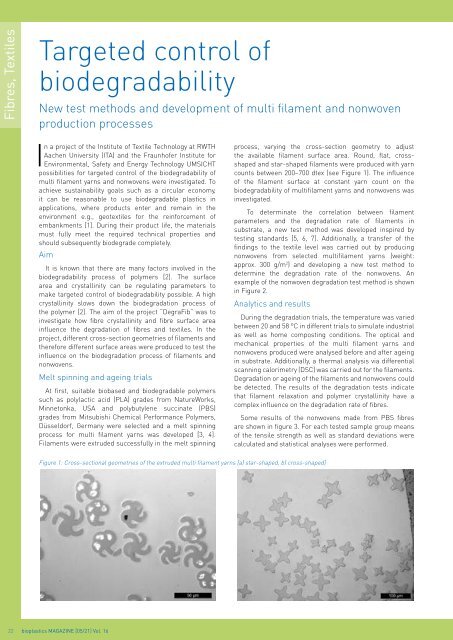issue 05/2021
Highlights: Fibres, Textiles, Nonwovens Biocomposites Basics: CO2-based plastics
Highlights:
Fibres, Textiles, Nonwovens
Biocomposites
Basics: CO2-based plastics
Create successful ePaper yourself
Turn your PDF publications into a flip-book with our unique Google optimized e-Paper software.
Fibres, Textiles<br />
Targeted control of<br />
biodegradability<br />
New test methods and development of multi filament and nonwoven<br />
production processes<br />
In a project of the Institute of Textile Technology at RWTH<br />
Aachen University (ITA) and the Fraunhofer Institute for<br />
Environmental, Safety and Energy Technology UMSICHT<br />
possibilities for targeted control of the biodegradability of<br />
multi filament yarns and nonwovens were investigated. To<br />
achieve sustainability goals such as a circular economy,<br />
it can be reasonable to use biodegradable plastics in<br />
applications, where products enter and remain in the<br />
environment e.g., geotextiles for the reinforcement of<br />
embankments [1]. During their product life, the materials<br />
must fully meet the required technical properties and<br />
should subsequently biodegrade completely.<br />
Aim<br />
It is known that there are many factors involved in the<br />
biodegradability process of polymers [2]. The surface<br />
area and crystallinity can be regulating parameters to<br />
make targeted control of biodegradability possible. A high<br />
crystallinity slows down the biodegradation process of<br />
the polymer [2]. The aim of the project “DegraFib” was to<br />
investigate how fibre crystallinity and fibre surface area<br />
influence the degradation of fibres and textiles. In the<br />
project, different cross-section geometries of filaments and<br />
therefore different surface areas were produced to test the<br />
influence on the biodegradation process of filaments and<br />
nonwovens.<br />
Melt spinning and ageing trials<br />
At first, suitable biobased and biodegradable polymers<br />
such as polylactic acid (PLA) grades from NatureWorks,<br />
Minnetonka, USA and polybutylene succinate (PBS)<br />
grades from Mitsubishi Chemical Performance Polymers,<br />
Düsseldorf, Germany were selected and a melt spinning<br />
process for multi filament yarns was developed [3, 4].<br />
Filaments were extruded successfully in the melt spinning<br />
process, varying the cross-section geometry to adjust<br />
the available filament surface area. Round, flat, crossshaped<br />
and star-shaped filaments were produced with yarn<br />
counts between 200–700 dtex (see Figure 1). The influence<br />
of the filament surface at constant yarn count on the<br />
biodegradability of multifilament yarns and nonwovens was<br />
investigated.<br />
To determinate the correlation between filament<br />
parameters and the degradation rate of filaments in<br />
substrate, a new test method was developed inspired by<br />
testing standards [5, 6, 7]. Additionally, a transfer of the<br />
findings to the textile level was carried out by producing<br />
nonwovens from selected multifilament yarns (weight:<br />
approx. 300 g/m 2 ) and developing a new test method to<br />
determine the degradation rate of the nonwovens. An<br />
example of the nonwoven degradation test method is shown<br />
in Figure 2.<br />
Analytics and results<br />
During the degradation trials, the temperature was varied<br />
between 20 and 58 °C in different trials to simulate industrial<br />
as well as home composting conditions. The optical and<br />
mechanical properties of the multi filament yarns and<br />
nonwovens produced were analysed before and after ageing<br />
in substrate. Additionally, a thermal analysis via differential<br />
scanning calorimetry (DSC) was carried out for the filaments.<br />
Degradation or ageing of the filaments and nonwovens could<br />
be detected. The results of the degradation tests indicate<br />
that filament relaxation and polymer crystallinity have a<br />
complex influence on the degradation rate of fibres.<br />
Some results of the nonwovens made from PBS fibres<br />
are shown in figure 3. For each tested sample group means<br />
of the tensile strength as well as standard deviations were<br />
calculated and statistical analyses were performed.<br />
Figure 1: Cross-sectional geometries of the extruded multi filament yarns [a) star-shaped, b) cross-shaped]<br />
22 bioplastics MAGAZINE [<strong>05</strong>/21] Vol. 16

















